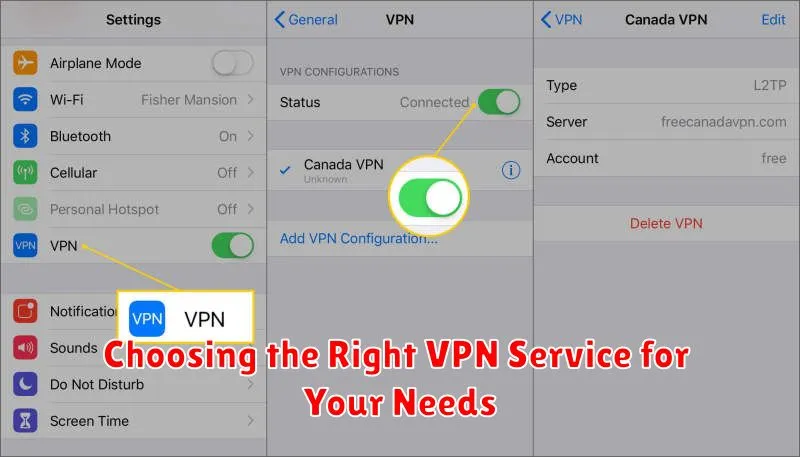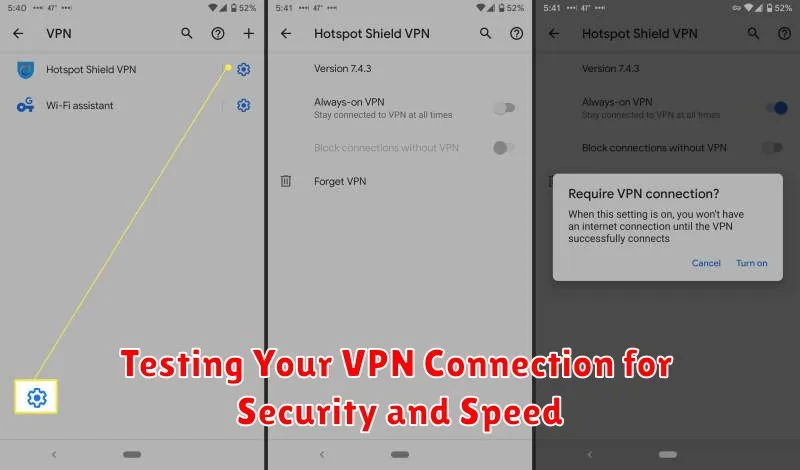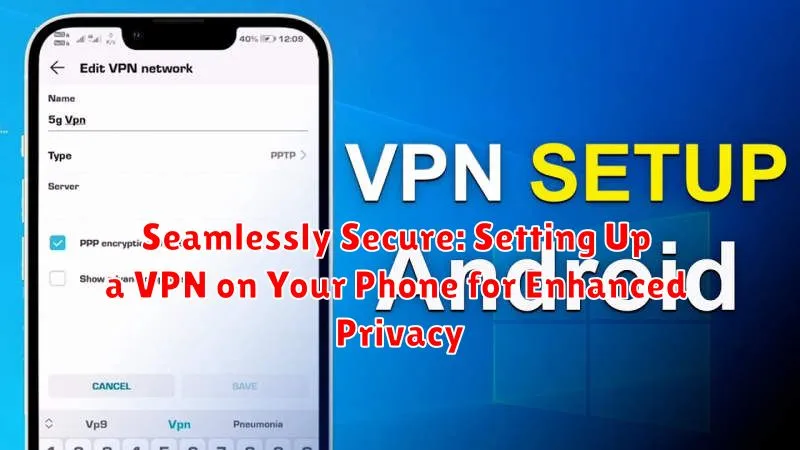In today’s interconnected world, online privacy is more crucial than ever. With increasing cyber threats and data breaches, safeguarding your personal information is paramount. A Virtual Private Network (VPN) offers a robust solution, encrypting your internet connection and masking your IP address. Setting up a VPN on your phone is a simple yet effective way to enhance your privacy and security, whether you’re browsing on public Wi-Fi, accessing sensitive data, or simply seeking a more secure online experience. This article provides a comprehensive guide to seamlessly securing your mobile connection by setting up a VPN on your phone. Learn how to choose the right VPN for your needs and easily configure it for optimal privacy and security.
A VPN acts as a secure tunnel for your internet traffic, shielding your online activity from prying eyes. By routing your connection through a VPN server, your IP address is masked, making it difficult for websites, advertisers, and malicious actors to track your online movements. This enhanced privacy is especially important when using public Wi-Fi networks, which are often vulnerable to security breaches. This guide will walk you through the process of setting up a VPN on your phone, ensuring your online privacy and security are fortified regardless of where you connect. Learn how to choose the best VPN provider, install the app, and configure the settings for seamless and secure browsing on your mobile device.
Understanding the Benefits of Using a VPN on Your Phone
Using a VPN on your phone offers several significant advantages for enhancing your online privacy and security. A VPN, or Virtual Private Network, creates an encrypted tunnel for your internet traffic, shielding your data from prying eyes.
One key benefit is increased privacy. By masking your IP address, a VPN prevents websites and online services from tracking your online activities and collecting personal data. This is particularly important when using public Wi-Fi networks, which are often unsecured and vulnerable to attacks.
Enhanced security is another crucial benefit. The encryption provided by a VPN protects your data from hackers and cybercriminals, especially on public Wi-Fi. This safeguards sensitive information like passwords, financial details, and browsing history.
VPNs also allow you to bypass geographical restrictions. By connecting to a VPN server in a different location, you can access content that may be blocked in your region. This is helpful for accessing streaming services or websites restricted to specific countries.
Choosing the Right VPN Service for Your Needs

Selecting the right VPN service is crucial for maximizing your mobile privacy. Several key factors should guide your decision. Consider the VPN provider’s logging policy. A strict no-logs policy ensures your online activity isn’t tracked or stored. Security features are also paramount. Look for providers offering strong encryption protocols, such as AES-256, and features like a kill switch to protect your data if the VPN connection drops.
Performance is another essential consideration. A fast and reliable VPN minimizes lag and buffering, especially for activities like streaming or gaming. Evaluate the VPN’s server network. A larger network with servers in diverse locations offers more flexibility and potentially faster speeds. Finally, consider the pricing and ensure the chosen VPN fits your budget while offering the necessary features and performance.
Downloading and Installing a VPN App on Your Phone
Once you’ve selected a VPN provider, the next step is downloading and installing their app on your phone. This process is generally straightforward and similar across different platforms, whether you’re using an Android or iOS device.
For Android Devices:
Open the Google Play Store app on your phone. Search for the name of your chosen VPN provider. Locate the official app and tap “Install.” Grant any necessary permissions during the installation process.
For iOS Devices (iPhone/iPad):
Open the App Store app. Search for your VPN provider’s name. Find the official app and tap “Get.” You may be prompted to authenticate with your Apple ID or use Face ID/Touch ID. After authentication, the app will begin downloading and installing.
After successful installation, the VPN app icon will appear on your home screen or app drawer.
Configuring the VPN Connection Settings
Most VPN apps offer a simplified setup process, often requiring minimal user configuration. However, some advanced settings may be available for users who require more granular control over their VPN connection. These settings can usually be accessed through the app’s settings menu.
Protocol Selection: Different VPN protocols offer varying balances of security and speed. Common options include OpenVPN, WireGuard, and IKEv2. Your chosen VPN provider may recommend a default protocol, but allowing you to switch protocols can be useful for troubleshooting connection issues or optimizing for specific needs. Research the benefits of each protocol to understand which best suits your requirements.
Split Tunneling: This feature allows you to select which apps route their traffic through the VPN and which apps use your regular internet connection. Split tunneling can be useful for accessing local network devices while connected to the VPN or for prioritizing speed for certain apps that don’t require VPN protection.
Custom DNS Servers: While most VPN providers offer their own DNS servers, you might choose to use a third-party DNS service for enhanced privacy or ad blocking. This setting usually allows you to input the preferred DNS server addresses.
Connecting to a VPN Server Location
Once your VPN app is installed and configured, connecting to a VPN server is usually a straightforward process. Most apps feature a prominent “connect” button. Tapping this button often automatically connects you to the optimal server based on your location and network conditions. However, you typically have the option to manually select a server location.
Choosing a server location influences several aspects of your VPN connection. Connecting to a nearby server generally results in faster speeds. If you’re using a VPN for privacy or security while browsing locally, a nearby server is usually sufficient. However, if you need to access content or services restricted to a specific geographic region, you’ll need to connect to a server in that target location.
VPN apps typically present a list of available server locations. This list might be organized by continent, country, or even city. Some apps provide additional information, such as server load and latency, to help you choose the best option. Selecting a server is usually as simple as tapping on it in the list. After selecting a server, the app initiates the connection. The time it takes to connect can vary depending on your network and the server’s distance.
Troubleshooting Common VPN Connection Issues
Encountering connectivity problems with your VPN? Don’t worry, it’s often a simple fix. Here are some common issues and how to resolve them:
Network Connectivity
Check your internet connection without the VPN active. If your regular internet isn’t working, the VPN isn’t the problem. Try restarting your router or contacting your internet service provider.
VPN Server Issues
A selected server might be overloaded or down. Try switching to a different server location within your VPN app.
App or System Errors
Sometimes the VPN app itself can experience glitches. Force-close the app and restart it. If the problem persists, try reinstalling the app. Ensure your phone’s operating system is also up-to-date.
Firewall or Antivirus Interference
Occasionally, firewalls or antivirus software can block VPN connections. Check your firewall settings and add the VPN app to the exceptions list or temporarily disable the firewall to test if it resolves the issue.
Testing Your VPN Connection for Security and Speed

Once your VPN is active, verifying its effectiveness is crucial. This involves checking for IP address leaks and assessing the impact on your connection speed.
Checking for IP Address Leaks
An IP address leak defeats the purpose of a VPN. Use a reputable IP address lookup tool (search for one online) while your VPN is connected. The displayed IP address and location should differ from your actual location. If your real IP address is revealed, your VPN isn’t functioning correctly and requires further investigation.
Assessing VPN Speed Impact
VPNs can affect connection speed due to routing traffic through secure servers. Perform speed tests (search for “internet speed test” online) both with and without your VPN active. Note the differences in download and upload speeds. While some slowdown is expected, a dramatic decrease might warrant exploring different VPN server locations or considering alternative VPN providers.
Optimizing Your VPN Settings for Performance and Privacy
Choosing the right VPN protocol can significantly impact both speed and security. Experiment with available protocols within your VPN app. Generally, OpenVPN offers a strong balance of security and performance, while WireGuard is known for its speed. IKEv2 is another solid choice, especially for mobile devices.
Consider enabling the kill switch feature. This crucial setting prevents data leaks if your VPN connection drops unexpectedly, ensuring your online activities remain private.
DNS leak protection is another important setting. A DNS leak can expose your browsing history even when using a VPN. Ensure this feature is activated within your VPN app. Some VPNs offer their own secure DNS servers for enhanced privacy.
Your VPN’s server location can impact performance. Connecting to a server closer to your physical location often results in faster speeds. However, prioritize servers in countries with strong privacy laws if your primary concern is anonymity.
If your VPN offers split tunneling, consider which apps should use the VPN connection. Routing only essential traffic through the VPN can improve performance.

